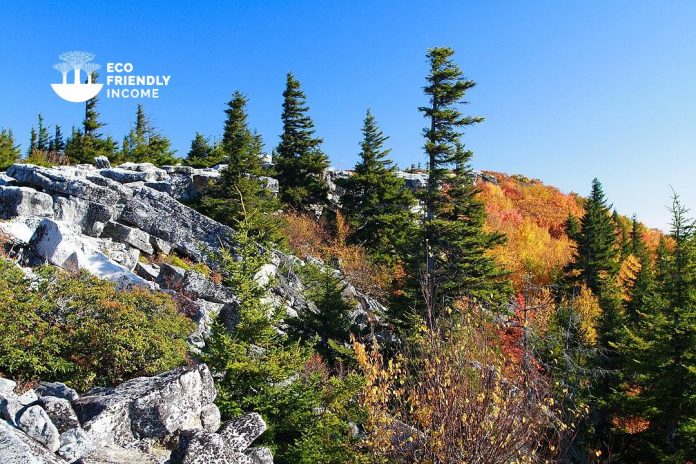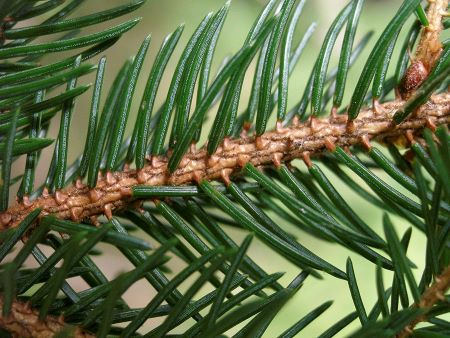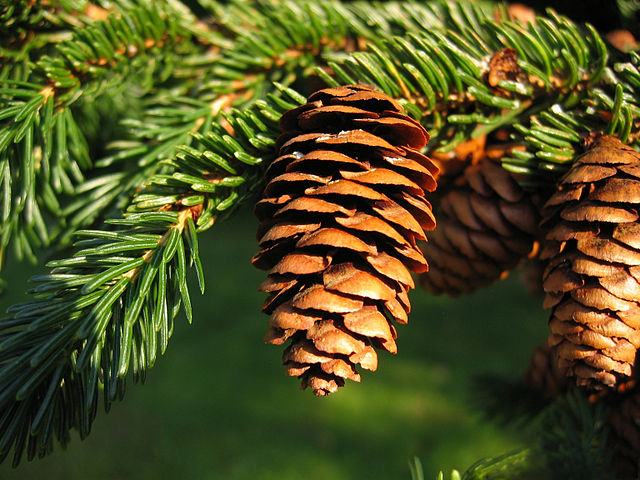
Featured Photo by Forest Wander / CC BY-SA 2.0
A field guide on how to identify and propagate Red Spruce (Picea rubens), a hardy tree that is native to eastern North America.
How to Identify Red Spruce (Picea rubens)
Leaves

Red spruce needles are linear-shaped, with entire margins (smooth). They grow on the stems in alternate arrangements.
The needles are quite small, around 1.5 inches each.
A good way to identify spruce is to pluck a needle and pinch it between your fingers.
It should roll well, as opposed to fir needles, which are flat and don’t really roll.
Bark
The Red Spruce tree has a bark that ranges in color from gray-brown to reddish-brown and is furrowed on larger specimens.
A good way to differentiate spruce from fir is to look at the bark for resin blisters. Red spruce doesn’t have the tell-tale resin blisters that can identify fir trees.
Cones

Red spruce cones are green at a young age and turn reddish-brown as they mature.
When mature, the cone scales are easily detachable.
Each cone measures roughly 3-5cm.
Flowering Season
Young cones appear on the trees in spring and mature by the end of summer.
Cones open from late summer through autumn and even in winter.
Habitat
Red spruce grows on soils ranging from dry to moist, and frequently on shallow soil. It tolerates intermediate soils, between well-drained upland sites and bogs. It is found in the deciduous and mixed forest zone.
You can find red spruce growing naturally only in a small area. It is limited to the Eastern Canadian Forests, the Acadian, Great Lakes, & Eastern Forests-Boreal Transition.
Some other understory plants that associate with red spruce are:
- Blueberry (Vaccinium myrtilloides)
- Hobblebush (Viburnum lantanoides)
- Witherod (Viburnum cassinoides)
- Rhodora (Rhododendron canadense)
- Sheep Laurel (Kalmia angustifolia)
- Creeping Snowberry (Gaultheria hispidula)
- Wintergreen (Gaultheria procumbens)
Wildlife Value
Red spruce forests provide important winter shelter for deer and moose.
These forests are also home to small animals like ruffed grouse, snowshoe hare, and woodcock. Many songbirds and mammals also live in these forests.
How to Propagate Red Spruce (Picea rubens)

Hardiness Zone: 3-7

Soil Type: Slightly acidic clay, loam, sand.

Water: Normal

Exposure: Full Sun to Partial Shade
You can propagate red spruce with two methods:
- Stem Cuttings: It provides established trees faster, but is tricky, and will probably have a lower success rate.
- By Seed: The success rate is high but takes longer to get established saplings.
I’ve never had great success propagating conifers by taking cuttings, if you’re reading this and have tricks to make it work, share them down below in the comments!
What has worked for me, on the other hand, is growing by seed.
Let’s take a look:
How to Propagate Red Spruce (Picea rubens) by Seed
Now unless you live on the east coast of Canada, and U.S., you probably won’t have access to red spruce trees.
In that case, you can order the seeds online at Mount Royal Seeds.
Otherwise, it’s as easy as going on a hike, identifying the tree, and collecting the seeds.
How to Harvest Seeds
The best time of the year to collect cones for seeds is late summer to mid-autumn.
You want them to be mature but you also want to collect them before they open up and lose their seeds.
To get the seeds, just place the cones in a brown paper bag to dry, and they will open naturally.
Next, you just have to knock the seeds out of the cone.
Stratification & Sowing
To get the best results when germinating red spruce seeds, it’s best to stratify them first. Here’s how:
- Put the seeds in a labeled bag with moist sand or vermiculite.
- Store the bag in the freezer for 20 days.
- Remove from freezer and let sit in room temperature water for 12 hours.
- Put the bag in the refrigerator for another 10 days.
- Sow the seeds in a peat moss and sand mix, water gently, and cover with plastic wrap to keep the mix moist.
After this process, the seeds should germinate within a week.
FAQ
Q: What is the difference between white spruce and red spruce?
A: Red spruce needles are shorter than white spruce needles, and the bark of older specimens shows a different color. Red spruce is more reddish brown while white spruce is more grayish-brown. Red spruce is also more shade tolerant than white spruce.
Q: Why is it called Red Spruce?
A: It’s mainly to tell it apart from other spruce species, red spruce bark color is brown, slightly on the red side.
Q: What is red spruce wood used for?
A: Red Spruce is a highly valuable tree in the northeast region. Its wood is characterized by its lightweight, softness and slight red tint. The main uses of this tree are in the lumber and pulpwood industries. In the landscaping industry, it’s useful for more shaded areas.
Q: Is red spruce Adirondack spruce?
A: Yes, red spruce grows specifically in the Adirondack area, which is why it is also called Adirondack spruce.
